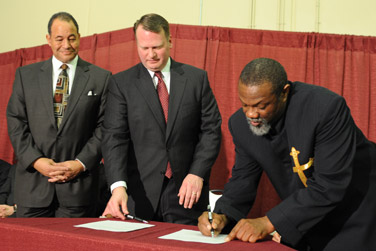News
Downtown expansion tied to revitalization

From left, Donald Boswell, a member of the UB Foundation Finance Committee; committee chair Robert Denning; and the Rev. Michael Chapman sign an agreement of understanding to collaborate on East Side revitalization. Photo: NANCY J. PARISI
The Rev. Michael Chapman, pastor of St. John Baptist Church and president of the Oak-Michigan Housing Development Corp, a not-for-profit housing development corporation of St. John Baptist Church, announced on April 5 a step forward for a well-devised, systematic, business plan to revitalize Buffalo’s East Side and the critical role of UB in achieving this goal.
In front of hundreds of supporters, parishioners, elected officials and community leaders, Chapman outlined the Oak-Michigan Housing Development Corp.’s and the St. John Fruit Belt Development Corp.’s $500 million East Side development plan, which he said will be a catalyst for economic development and improvement in quality of life in one of Buffalo’s poorest neighborhoods.
Chapman said this plan will focus on development of a High Street commercial district, to be populated primarily by minority-owned businesses, as well as the construction of 150 new, multi-family townhouses for residents of McCarley Gardens, new housing for seniors, new recreational facilities, a boxing facility and new infrastructure in the 42-block Fruit Belt neighborhood adjacent to the Buffalo Niagara Medical Campus.
“This is the most comprehensive urban development under way anywhere in the country,” Chapman said. “Working with more than 63 community partners and leaders in government, we will move forward with a bold business plan to revitalize a community beset for decades by poverty, joblessness and inadequate housing. We anticipate 15,000 employment opportunities through construction, new businesses and support services.”
The vision for East Side Development includes business-development entrepreneurship, $60 million in new townhouses, two low-rise senior residential buildings, a $20 million youth facility, a $234 million High Street commercial development project, a building to house corporate offices, a youth boxing and Business Entrepreneurship Training Center for 300-500 young adults age 21-35, and $20 million invested in infrastructure, sidewalks, curbs, lighting, greenery, an East Side mental health facility, assisted living and veterans residential facilities, as well as a Fruit Belt grocery and petroleum station.
For the plan to be successful, Chapman said, it is essential that UB implement the UB 2020 plan to develop its Downtown Campus. Chapman explained that the university's downtown expansion will produce the critical mass—in new jobs and economic impact—needed for East Side revitalization to become reality.
As a first step toward supporting the goal for East Side revitalization, the UB Foundation will purchase McCarley Gardens and make the property available to the university for the purpose of developing its Downtown Campus. Sale of McCarley Gardens is contingent upon HUD’s approval of several factors be completed by Oak-Michigan Housing Development Corporation and UB, and approved by HUD. These include development of a relocation plan for McCarley Gardens’ residents and establishing a six-member joint panel to conduct a two-year assessment of economic opportunities for Fruit Belt and East Side residents.
Oak-Michigan Housing Development Corp. anticipates it will begin construction of new townhouses for McCarley Gardens residents by 2013 and all conditions for sale of the property will be met by 2017.
“The UB Foundation strongly supports the initiatives of St. John Baptist Church and its not-for-profit organizations for development of Buffalo’s East Side, as well as UB’s vision for expanding in downtown Buffalo,” said Robert Denning, chair of the UB Foundation’s Finance Committee and president and CEO of Perry’s Ice Cream.
“We have reached an agreement with the Oak-Michigan Housing Development Corp. to eventually acquire the McCarley Gardens property. We view this investment as an important first step toward realizing the vision of both the church and the university.”
President John B. Simpson cautioned, however, that the UB 2020 plan for downtown campus development—while critical to revitalizing the East Side—is at risk. For UB 2020 to go forward, Simpson said, the state must adopt reforms proposed in the Public Higher Education Empowerment and Innovation Act (PHEEIA) and stop cutting UB’s budget.
“We have a shared vision for revitalization and we agree on how to get it done,” Simpson said. “Now we need the state to let us do this. We need the tools to get the job done.”
Passage of PHEEIA will help UB to achieve UB 2020, thereby creating 6,700 new jobs at UB and 20,000 construction jobs, and adding nearly $2 billion in additional economic impact to Western New York.
University leaders say that these common-sense reforms provide a predictable tuition plan that differentiates the cost and quality of education at research universities like UB and allows UB to keep the tuition students pay, instead of sending it to Albany to fill budget gaps. PHEEIA also gives UB the ability to enter into partnerships to leverage private sector funding as a way to create greater economic growth in Western New York.
Buffalo Mayor Byron Brown, Assemblywoman Crystal Peoples-Stokes and state Sen. Antoine Thompson each expressed strong support for the plan to revitalize Buffalo’s East Side and implored members of the community to rally together to help legislators in Albany understand that passage of PHEEIA is critical to Western New York's economic future.
The Rev. Richard Stenhouse of Bethel AME Church and president of the Jeremiah Partnership, made up of eight pastors of East Side churches, also expressed support for PHEEIA and the efforts to revitalize the East Side.


Reader Comments